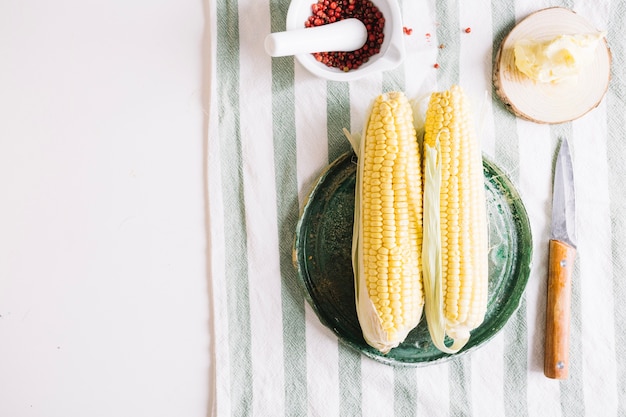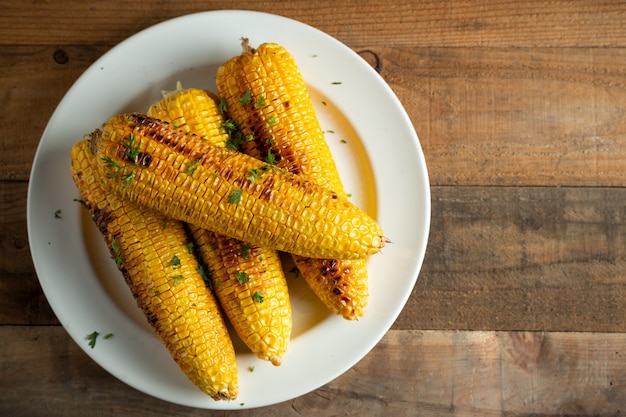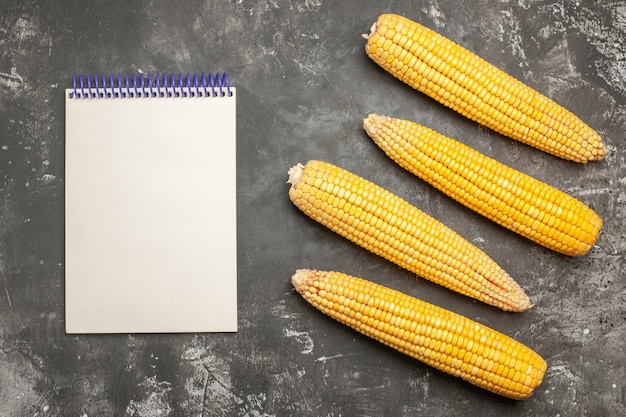Ah, corn on the cob. Just the thought of it brings back memories of sunny days, the aroma of grilling, and those sweet, juicy kernels bursting with flavor. It's a summer staple, and honestly, there's nothing quite like it. But as much as I love it, I've had my share of disappointments when it comes to cooking it. Overcooked, mushy corn? No thank you! Undercooked, crunchy kernels? Not for me either.
So, after years of experimenting and a fair few burnt cobs, I've finally cracked the code. This is my foolproof guide to cooking the perfect corn on the cob, ensuring each bite is a delightful explosion of sweetness and tenderness.
Part 1: Choosing the Right Corn

The journey to perfect corn starts right at the beginning, with selecting the freshest, most vibrant cobs.
1. Look for the Signs
Remember, fresh corn is your key to success. To spot a winner, check out these telltale signs:
- Shiny Husks: A good cob boasts lush, green husks that are glossy and moist. Avoid any with dried, brown husks – that's a sign they've been hanging around a bit too long.
- Firm Kernels: Gently peel back a few husks to reveal the kernels. They should be plump, firm, and not too soft. Think of a well-hydrated kernel – that's what you're looking for!
- Silk Colour: The silk, those thin strands attached to the kernels, should be bright yellow or brown – never black. Black silk indicates the corn is past its prime and might not be as tasty.
2. The Freshness Test
I always give my corn a little sniff test. Fresh corn has a sweet, grassy aroma. If it smells musty or off, it's best to leave it on the shelf. Trust your nose – it knows!
Part 2: Preparing the Corn

Once you've got your hands on some top-notch corn, it's time to get it ready for cooking.
1. Shucking and Cleaning
Shucking the corn is a bit of an art form, but it's easier than you think. Grab the corn at the bottom, pull back the husks, and gently twist them off. You can usually keep the husks intact, but if they're too damaged, simply remove them and discard.
Next, you need to get rid of the silk. This is where I like to use a little trick – I run the corn under cold water and gently rub the silks against the cob. The water helps loosen them, making them easier to remove.
2. Storing Corn
If you're not cooking the corn immediately, it's best to store it in the fridge to keep it fresh. Wrap the shucked corn in plastic wrap and store it in the crisper drawer for up to 3 days.
Part 3: Cooking Methods

Now for the fun part – choosing how to cook your corn. There are so many ways to go, and each one has its own charm.
1. Boiling
This is the classic, tried-and-true method. It's simple, reliable, and yields tender, juicy corn.
1.1 The Boiling Method
Ready to boil? Here's how to do it:
- Fill a large pot with water. Add a tablespoon of salt for flavour. This helps season the corn and keeps it from becoming bland.
- Bring the water to a rolling boil. This ensures the corn cooks quickly and evenly.
- Gently lower the corn into the boiling water. Don't overcrowd the pot – give those cobs some space.
- Cook for 3-5 minutes, depending on the thickness of the cob. Thicker cobs will need a little longer.
- Remove the corn from the pot using tongs and immediately plunge it into an ice bath to stop the cooking process. This prevents the corn from overcooking and keeps it crisp.
- Serve immediately or refrigerate until ready to eat.
1.2 Tips for Boiling
To prevent the corn from sticking together, try cooking them in a single layer. If you're cooking a large batch, you may need to do it in batches.
2. Grilling
Grilling adds a smoky flavour that elevates corn to another level. It's perfect for those summer barbecues.
2.1 The Grilling Method
Get ready for some smoky deliciousness:
- Preheat your grill to medium heat. This ensures the corn cooks evenly and doesn't burn.
- Remove the husks and silk from the corn.
- Brush the corn with a little bit of olive oil or melted butter. This helps prevent the corn from sticking to the grill and adds flavor.
- Place the corn on the grill, turning every few minutes to ensure even cooking. Don't let it sit on one side for too long!
- Cook for about 10-15 minutes, until the kernels are tender and slightly charred. Those grill marks are a sign of perfection!
- Remove from the grill and serve immediately.
2.2 grilling tips
To prevent the corn from sticking to the grill, try soaking it in water for a few minutes before grilling. You can also add a little bit of salt to the water to enhance the flavour.
3. Microwave
This is a quick and easy option when you're short on time.
3.1 The Microwave Method
A quick and easy way to cook corn:
- Remove the husks and silk from the corn.
- Wrap the corn in a paper towel and place it in a microwave-safe dish. The paper towel helps absorb moisture and prevents splattering.
- Microwave on high for 3-4 minutes, depending on the thickness of the cob. Keep an eye on it – some microwaves cook faster than others.
- Remove from the microwave, let cool for a few minutes, and serve immediately.
3.2 Microwave Tips
Don't forget to use a microwave-safe dish! And if you're using a very powerful microwave, you might need to cook the corn for a shorter amount of time.
Part 4: Determining Doneness
Knowing when your corn is perfectly cooked is key to avoiding those dreaded mushy or crunchy bites.
1. The Visual Test
The kernels should be plump and slightly shiny. If they look wrinkled or shriveled, the corn is overcooked.
2. The Touch Test
Gently press on a kernel. It should be tender but not mushy. If it feels hard or firm, it needs more cooking time.
3. The Taste Test
This is the ultimate test! Take a bite and see if the kernel is sweet, tender, and juicy.
Part 5: Serving Suggestions
Once your corn is cooked to perfection, it's time to get creative with how you serve it.
1. Simple and Classic
A good dollop of butter and a sprinkle of salt and pepper is all you need for a classic corn on the cob experience.
2. Flavour Boost
Add some zing with a squeeze of lemon juice or a sprinkle of lime zest.
3. Spicy Kick
For those who like a little heat, try drizzling some hot sauce or adding a sprinkle of cayenne pepper.
4. Herb Infusion
Elevate your corn with a sprinkle of fresh herbs like parsley, cilantro, or chives.
5. The Sweet and Savoury Twist
For a unique flavour combination, try drizzling a little honey or maple syrup on your corn.
6. corn salad
Dice your cooked corn and toss it with other veggies, herbs, and a light vinaigrette for a refreshing salad.
Part 6: Leftovers
Have leftover corn on the cob? No problem! You can easily store it in the fridge for up to 3 days.
1. Storing Leftovers
To store leftover corn, wrap the cobs in plastic wrap or aluminum foil and place them in the fridge.
2. Using Leftovers
Leftover corn is great for adding to salads, soups, or even using as a topping for pizza.
Part 7: Common Mistakes
We all make mistakes, even when it comes to cooking corn. Here are some common errors to avoid.
1. Overcooking
Overcooked corn is mushy and loses its sweetness. Stick to the recommended cooking times to avoid this.
2. Undercooking
Undercooked corn is crunchy and not as flavourful. Make sure you cook it long enough to ensure tenderness.
3. Not Removing the Silk
Leaving the silk on the cob will make it taste bitter.
4. Not Seasoning Properly
Corn is a blank canvas, so don't be afraid to season it with your favourite herbs, spices, or sauces.
Part 8: FAQs
Let's address some common questions about cooking corn on the cob.
1. Can I Cook Corn on the Cob Without Shucking It?
You can! It's a great way to get a smoky flavour. Simply soak the corn in water for 30 minutes, then grill it for about 20-25 minutes, turning every few minutes. Once cooked, carefully remove the husks and silk. This method adds a rustic charm and enhances the natural sweetness of the corn.
2. How Can I Tell If Corn Is Bad?
Look for signs like dried, brown husks, soft kernels, and black silk. If the corn smells musty or off, it's best to discard it.
3. Is There a Difference Between sweet corn and field corn?
Yes, there is! Sweet corn is what you usually see in grocery stores and is specifically bred for its sweetness and tenderness. Field corn, on the other hand, is used for animal feed or to make corn products like cornmeal.
4. Can I Freeze Corn on the Cob?
It's not recommended to freeze corn on the cob. It's best to freeze corn kernels instead. Simply shuck the corn and cut the kernels off the cob. Then, blanch the kernels in boiling water for 2-3 minutes, drain them, and freeze them in airtight containers.
5. What If I Don't Have an Ice Bath?
If you don't have an ice bath, you can simply run the corn under cold water to stop the cooking process.
Part 9: The Science Behind Perfect Corn
Beyond the simple steps, understanding a bit of the science behind corn can make you a cooking pro. Corn kernels contain sugars that convert to starch during cooking. To achieve optimal sweetness and tenderness, we need to manage this conversion.
Here's a breakdown:
- Boiling: Boiling cooks the corn quickly, limiting the conversion of sugars to starch. It's a great method for preserving that sweet flavor.
- Grilling: Grilling brings a smoky flavor but also converts more sugars to starch, resulting in a slightly firmer texture. The charring adds complexity to the taste profile.
- Microwave: Microwaving is the fastest method, but it can lead to inconsistent cooking and potentially overcooked kernels.
The perfect method for you depends on your preference for sweetness, texture, and flavor.
Part 10: The Importance of Freshness
I can't stress enough the importance of using fresh corn. The difference in taste is remarkable. If you're lucky enough to have access to freshly picked corn, grab it! It'll be the best corn you've ever tasted.
Here are some tips for getting the freshest corn:
- Visit a farmers market: Farmers markets are a great place to find fresh, local produce.
- Ask your local farmer: Many farmers sell their produce directly from their farms.
- Pick it yourself: If you have the opportunity to pick your own corn, do it! It's a fun and rewarding experience.
Part 11: Corn on the Cob: A Culinary Tradition
Corn on the cob isn't just a delicious food; it's a culinary tradition enjoyed by people all over the world. From barbecues to potlucks, it's a versatile dish that brings people together.
Whether you're enjoying it with your family, friends, or at a festive gathering, corn on the cob is a reminder of the simple pleasures in life.
So, go ahead and grab some fresh corn, follow my guide, and enjoy the perfect bite!
Everyone is watching

How to Cook Frozen Lobster Tails Perfectly: A Step-by-Step Guide
RecipesLobster. Just the word conjures up images of lavish meals, special occasions, and a taste of luxury. But let's...

Pigs in a Blanket Cooking Time: How Long to Bake for Perfect Results
RecipesAh, pigs in a blanket. Just the name conjures up images of those delightful little parcels of crispy pastry en...

Pork Fillet Cooking Time: How Long to Cook It Perfectly
RecipesPork fillet, or tenderloin as it's sometimes called, is a real favourite in our house. It's so versatile, and...

The Ultimate Guide to Cooking Delicious Frankfurters
RecipesLet's face it, we all love a good frankfurter. It's a classic, simple, and always satisfying. But let's be rea...

Wolf Meat Recipes: A Guide to Cooking Wild Game
RecipesLet's be honest, you don't see wolf meat at your local butcher shop every day. It's a bit of a wild card, but ...
